| Srl | Item |
| 1 |
ID:
113530
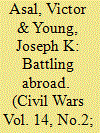

|
|
|
|
|
| Publication |
2012.
|
| Summary/Abstract |
Why are some terrorist organizations more likely to be targets of transnational counterterrorist operations? Previous work has identified characteristics of the environment or country involved to explain variation in targeting. We focus on characteristics of the violent organization to explain this variation. Using cross-national data on terrorist organizations and state targeting of these organizations, we identify several factors that help explain the variation in why some organizations are likely to be targeted while others are not.
|
|
|
|
|
|
|
|
|
|
|
|
|
|
|
|
| 2 |
ID:
113528
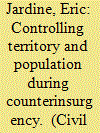

|
|
|
|
|
| Publication |
2012.
|
| Summary/Abstract |
Much of the literature on counterinsurgency focuses on the development of indigenous security capacity as the best policy for a state to achieve functional control over its people and territory, and, by extension, victory over an insurgency. This understanding serves as a guiding principle in Afghanistan. The policy erroneously maintains that a state's ability to exercise functional control over its territory is an almost exclusive product of state security capacity. In this article, I argue that the scope of a state's control over its national territory is more properly conceptualized as a function of both the state's aggregate security capacity and the costs of projecting power over distance. Functional territorial control, therefore, can be best maximized when the return on investment in security capacity is equal to the return on investment in factors that reduce the costs of power projection.
|
|
|
|
|
|
|
|
|
|
|
|
|
|
|
|
| 3 |
ID:
113527
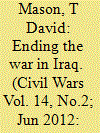

|
|
|
|
|
| Publication |
2012.
|
| Summary/Abstract |
Since the war in Iraq began in 2003, public debate over the war has centered on two options: either increase the number of US troops to defeat the insurgency, or withdraw US forces to reduce US losses. Empirical research on civil war termination suggests that neither of these two options is likely to produce a favorable outcome for the US or the Iraqi government. That same research points to the third option - negotiated settlement - that has been the most frequent manner in which civil wars have terminated in the post-Cold War era. I analyze what existing research on civil war termination suggests about how the civil war in Iraq can be brought to an end. Military victory over the insurgents is unlikely, but withdrawal increases the risk of state failure. A negotiated settlement would require a credible third-party mediator to broker an agreement between the government, Sunni insurgents, and Shiite militias, thereby isolating foreign jihadists to spoiler status. Implementation of the settlement and the durability of the peace would be enhanced by multinational peacekeeping forces.
|
|
|
|
|
|
|
|
|
|
|
|
|
|
|
|
| 4 |
ID:
113529


|
|
|
|
|
| Publication |
2012.
|
| Summary/Abstract |
Theories of environmental degradation as a predictor of armed conflict have gained momentum as scientists warn of the catastrophic consequences of global warming. Despite an increasing number of studies that emphasize this causal relationship, the literature is scant on the reverse linkage - environmental consequences of civil war. This study seeks to examine the impact of civil war on the environment and argues that state forces deliberately transform the environment to undermine rebels' ability to wage a war. Using data from the Kurdish conflict in Turkey, this study presents evidence for the devastating effects of civil war on deforestation and the agrarian economy.
|
|
|
|
|
|
|
|
|
|
|
|
|
|
|
|
| 5 |
ID:
113526
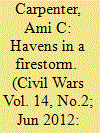

|
|
|
|
|
| Publication |
2012.
|
| Summary/Abstract |
The invasion of Iraq caused the collapse of more than one regime, setting in motion citywide and neighborhood-level changes that ruptured the stability of sectarian relations. Surprisingly, some areas of the city were able to prevent this rupture and keep sectarian militias at bay. This article is based on a year-long comparative research of neighborhoods in Baghdad wherein residents either (1) rejected sectarianism and mobilized to protect their neighbors from attacks; or (2) adopted sectarian attitudes and behaviors. In this small-n study, the trajectory of conflict escalation and coping strategies were documented in the narratives of residents and analyzed through the conceptual lens of resilience and regime shifts. The results suggest five research directions for deeper analysis of resilience to violence.
|
|
|
|
|
|
|
|
|
|
|
|
|
|
|
|
| 6 |
ID:
113525


|
|
|
|
|
| Publication |
2012.
|
| Summary/Abstract |
In 2009, Witsenburg and Adano summarized their research on rainfall variability and livestock raiding in Marsabit District, Kenya. They found that livestock-related violence was higher in wetter months and wetter years, contrary to the common assumption that scarcity of water and pasture is the primary driver of livestock violence. Our research, focusing on the neighboring Turkana District of northwestern Kenya, attempted to replicate the Witsenburg and Adano findings for the years 1998-2009. We find significant relationships between rainfall variability and intensity of livestock violence, but in the opposite direction - drier months and drought years in Turkana District have higher intensities of violence.
|
|
|
|
|
|
|
|
|
|
|
|
|
|
|
|
| 7 |
ID:
113524
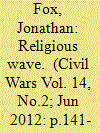

|
|
|
|
|
| Publication |
2012.
|
| Summary/Abstract |
This study examines how well five theories explain the extent of religious domestic conflict using data from 1960 to 2009 from the Political Instability Taskforce dataset. The results show that secularization theory's prediction of a decline in conflict and Samuel Huntington's predictions of a post-Cold War rise in religious identity conflict are inconsistent with actual conflict patterns. Predictions that religious conflicts will remain present are confirmed but this type of theory does not account for changes over time. David Rapoport's wave theory and Mark Juergensmeyer's religious resurgence theory provide the best explanation for a rise in religious conflict as a proportion of all domestic conflict that began in 1977. The results also show that Muslims have been increasingly and disproportionally involved in religious conflict, but not in a manner consistent with Huntington's predictions.
|
|
|
|
|
|
|
|
|
|
|
|
|
|
|
|